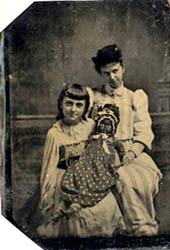
|
For millions of girls, dolls have served as intimate companions. Dolls offer the opportunity try out the role of mother to a doll or interacting with an imaginary adult as embodied by the doll. In such play, a child learns how she does and does not, or can and cannot, fit in with acceptable social roles. In that sense, dolls have power to reinforce prevailing gender roles. They are never just toys, because all play has a seriousness to it as well.
So what does it tell us that this white girl would also choose an emphatically black doll as her companion? To bring the doll to the photographer suggests the doll was a precious possession for this girl, who smiles very subtlely for the camera and looks the viewer squarely in the eye ― and she holds the dolls to meet our eye, too. By contrast, the woman with them, presumably the girl’s mother, looks aside, as if refusing to meet the viewer’s gaze.
In another image from the same session with the photographer (see below), the girl cradles the doll even more lovingly, while the mother holds an umbrella over them, as if protecting them from sun or rain ― or from view. Once again, the mother looks askance, with the same quizzical look on her face as in the other photograph. Just as doll-play could reinforce gender norms, doll-play could also reinforce racial roles. And yet ― Is this girl acting out a broader social drama of racial subjection, or is she modeling an intimacy that makes even her own mother look away?
|

